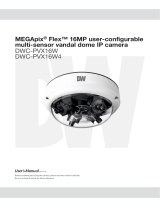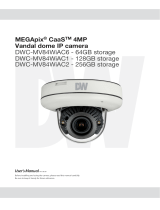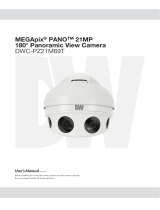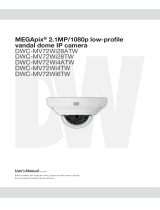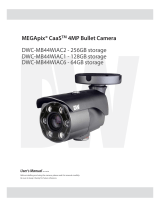Page is loading ...

User’s Manual
Ver. 08/20
Before installing and using the camera, please read this manual carefully.
Be sure to keep it handy for future reference.
MEGApix
®
Flex™ 16MP user-configurable
multi-sensor vandal dome IP camera
DWC-PVX16W
DWC-PVX16W2
DWC-PVX16W4

Safety Information
This symbol indicates that dangerous voltage
consisting a risk of electric shock is present within
this unit.
Warning Precaution
This exclamation point symbol is intended to alert the
user to the presence of important operating and
maintenance (servicing) instructions in the literature
accompanying the appliance.
TO REDUCE THE RISK OF ELECTRIC SHOCK, DO NOT REMOVE COVER (OR BACK) NO USER SERVICEABLE
PARTS INSIDE. REFER SERVICING TO QUALIFIED SERVICE PERSONNEL.
CAUTION
:
CAUTION
RISK OF ELECTRIC SHOCK.
DO NOT OPEN.
To prevent damage which may result in fire or electric shoc
hazard, do not expose this appliance to rain or moisture.
WARNING
Be sure to use only the standard adapter that is specified i
the specification sheet. Using any other adapter could caus
fire, electrical shock, or damage to the product
Incorrectly connecting the power supply or replacing battery
may cause explosion, fire, electric shock, or damage to th
product.
Do not connect multiple cameras to a single adapter.
Exceeding the capacity may cause excessive heat generation
or fire
Securely plug the power cord into the power receptacle.
Insecure connection may cause fire
When installing the camera, fasten it securely and firmly
A falling camera may cause personal injury.
Do not place conductive objects (e.g. screw drivers, coins,
metal items, etc.) or containers filled with water on top o
the camera. Doing so may cause personal injury due to fire
electric shock, or falling objects.
Do not install the unit in humid, dusty, or sooty locations.
Doing so may cause fire or electric shock
If any unusual smells or smoke come from the unit, stop
using the product. Immediately disconnect the power sorce
and contact the service center. Continued use in such a
condition may cause fire or electric shock
If this product fails to operate normally, contact the nearest
service center. Never disassemble or modify this product in
any way.
When cleaning, do not spray water directly onto parts of the
product. Doing so may cause fire or electric shock
WARNING
1.
2.
3.
4.
5.
6.
7.
8.
9.
10.
Precaution
Operating
• Before using, make sure power supply and all other parts are
properly connected.
• While operating, if any abnormal condition or malfunction
is observed, stop using the camera immediately and contact
your dealer.
Handling
• Do not disassemble or tamper with parts inside the camera.
• Do not drop the camera or subject it to shock or vibration as
this can damage the camera.
• Clean the clear dome cover with extra care. Scratches and
dust can ruin the quality of the camera image.
Installation and Storage
• Do not install the camera in areas of extreme temperature,
exceeding the allowed range.
• Avoid installing in humid or dusty environments.
• Avoid installing in places where radiation is present.
• Avoid installing in places where there are strong magnetic
ÿelds and electric signals.
• Avoid installing in places where the camera would be subject
to strong vibrations.
• Never expose the camera to rain or water.

Important Safety Instructions
Disposal of Old Appliances
1. When this crossed-out wheel bin symbol is attached to a product it means the product is covered by the
European Directive 2002/96/EC.
2. All electrical and electronic products should be disposed of separately form the municipal waste stream
stream in accordance to laws designated by the government or the local authorities.
3. The correct disposal of your old appliance will help prevent potential negative consequences for the
environment and human health.
4. For more detailed information about disposal of your old appliance, please contact your city office,
waste disposal service or the shop where you purchased the product.
This equipment has been tested and found to comply with the limits for a Class A digital device, pursuant to part 15 of the FCC Rules.
These limits are designed to provide reasonable protection against harmful interference when the equipment is operated in a commercial environment.
This equipment generates, uses, and can radiate radio frequency energy and, if not installed and used in accordance with the instruction manual, may cause
harmful interference to radio communications. Operation of this equipment in a residential area is likely to cause harmful interference in which case the user
will be required to correct the interferenece at his own expense.
1. Read these instructions. - All safety and operating instructions should be read before installation or operation.
2. Keep these instructions. - The safety, operating and use instructions should be retained for future reference.
3. Heed all warnings. - All warnings on the product and in the operating instructions should be adhered to.
4. Follow all instructions. - All operating and use instructions should be followed.
5. Do not use this device near water. - For example: near a bath tub, wash bowl, kitchen sink, laundry tub, in a wet
basement; near a swimming pool; etc.
6. Clean only with dry cloth. - Unplug this
product from the wall outlet before cleaning. Do not use liquid cleaners.
7. Do not block any ventilation openings. Install in accordance with the manufacturer’s instructions. - Slots and
openings in the cabinet are provided for ventilation, to ensure reliable operation of the product, and to protect it
from over-heating. The openings should never be blocked by placing the product on bed, sofa, rug or other similar
surfaces. This product should not be placed in a built-in installation such as a bookcase or rack unless proper
ventilation is provided and the manufacturer’s instructions have been adhere to.
8. Do not install near any heat sources such as radiators, heat registers, or other apparatus (including amplifiers)
that produce heat.
9. Do not defeat the safety purpose of the polarized or grounding-type plug. A polarized plug has two blades with
one wider than the other. A grounding type plug has two blades and a third grounding prong. The wide blade
or the third prong are provided for your safety. If the provided plug does not fit into your outlet, consult an
electrician for replacement.
10. Protect the power cord from being walked on or pinched particularly at plugs, convenience receptacles, and
the point where they exit from the apparatus.
11. Only use attachments/accessories specified by the manufacturer.
12. Use only with cart, stand, tripod, bracket, or table specified by the manufacturer,
or sold with the apparatus. When a cart is used, use caution when moving the cart/apparatus
combination to avoid injury from tip-over.
13. Unplug the apparatus during lightning storms or when unused for long periods of time.
14. Refer all servicing to qualified service personnel. Servicing is required when the apparatus has been damaged
in any way, such as power supply cord or plug is damaged, liquid has been spilled or objects have fallen into the
apparatus, the apparatus has been exposed to rain or moisture, does not operate normally, or has been
dropped.

Table of Contents
Introduction
Product & Accessories .....................................................................................................................................................................6
Parts Name ..........................................................................................................................................................................................7
Installation
Adjusting the Camera Angles ...................................................................................................................................................10
Installation ..........................................................................................................................................................................................9
Cabling ..............................................................................................................................................................................................11
SD Card ..............................................................................................................................................................................................13
Network Setup
DW IP Finder ....................................................................................................................................................................................14
Quick Start of Network Connection ........................................................................................................................................15
DDNS Registration ........................................................................................................................................................................16
Guide to Network Environment ...............................................................................................................................................17
Setup Cases .....................................................................................................................................................................................18
Port Forwarding .............................................................................................................................................................................20
Starting the IP Camera .................................................................................................................................................................21
Web Viewer
Basic Screen ....................................................................................................................................................................................22
Disassembling the Camera ...........................................................................................................................................................8
Camera Settings
VIDEO & AUDIO SETUP
Video Configuration ....................................................................................................................................................................23
OSD Configuration .......................................................................................................................................................................27
Region of Interest Configuration ............................................................................................................................................28
Audio Configuration ....................................................................................................................................................................29
Privacy Mask Configuration ......................................................................................................................................................30
CAMERA SETUP
Camera Image Adjustment .......................................................................................................................................................31
Camera Exposure Settings ........................................................................................................................................................32
Camera Day & Night Settings ..................................................................................................................................................33
Camera Backlight Settings ........................................................................................................................................................34
Camera White Balance ...............................................................................................................................................................35
Camera Image Enhancement ..................................................................................................................................................36
Video Enhancement ....................................................................................................................................................................37
NETWORK SETTINGS
Network Status ..............................................................................................................................................................................38
Network Settings ..........................................................................................................................................................................39
Auto IP Settings .............................................................................................................................................................................40
ONVIF Settings ...............................................................................................................................................................................41

Table of Contents (Continue)
Appendix...................................................................................................................................................80
FAQs..........................................................................................................................................................82
Dimensions...............................................................................................................................................83
Warranty...................................................................................................................................................84
Limits & Exclusions..................................................................................................................................85
Camera Settings
NETWORK SETUP (CONTINUED)
UPnP Settings ................................................................................................................................................................................42
DDNS Settings ...............................................................................................................................................................................43
FTP Settings ....................................................................................................................................................................................44
SMTP Settings ................................................................................................................................................................................45
SNMP Settings ...............................................................................................................................................................................46
RTSP Information ..........................................................................................................................................................................47
TRIGGER ACTION SETUP
Action Rules Configuration .......................................................................................................................................................48
Action Rules Add/Modify ...........................................................................................................................................................49
Image Transfer Configuration ..................................................................................................................................................50
Relayout Configuration ..............................................................................................................................................................51
EVENT SETUP
Event Rules Configuration .........................................................................................................................................................52
Motion Detection Configuration ............................................................................................................................................54
Temperature ...................................................................................................................................................................................55
Alarm Configuration ...................................................................................................................................................................56
RECORD SETUP
Record Configuration ..................................................................................................................................................................57
Recording List ................................................................................................................................................................................59
Recording Video ...........................................................................................................................................................................60
Storage Configuration ...............................................................................................................................................................61
SECURTY SETUP
IP Address Filter Configuration ...............................................................................................................................................63
RTSP Authentication Configuration ......................................................................................................................................64
IEEE 802.1X Configuration .........................................................................................................................................................65
HTTPS Configuration ...................................................................................................................................................................66
Certificates Configuration .........................................................................................................................................................67
Service Configuration .................................................................................................................................................................68
SYSTEM SETUP
System Information .....................................................................................................................................................................70
Firmware Update ..........................................................................................................................................................................71
Date & Time Settings ...................................................................................................................................................................73
DST Settings ...................................................................................................................................................................................74
User Management ........................................................................................................................................................................75
System Log .....................................................................................................................................................................................76
Factory Reset ..................................................................................................................................................................................77
Restart ...............................................................................................................................................................................................78
System Open Source License ...................................................................................................................................................79

Product & Accessories
Introducon -
Camera (Body)
Camera (sensor module block - 4ea)
Screws and
plastic a
nchors - 4pcs
Mounting template
Hex Allen wrench
Waterproof cap and gasket
Moisture absorber - 2pcs
and absorber guide
Quick set up guide
Test monitor cable
6

Part Name
Introducon -
Waterproof cap
RJ-45 Connector
Alarm in/out
Audio in/out
Video Select
2nd Video
Factory Reset
SD card slot
DC power jack
Reset buon
Test monitor
select switch
Test monitor cable slot
Safety wire
Magnetic track
Sensor module block
Base guide
Dome cover
7

Disassemble the camera
Installaon -
Before installing your camera, you have to read the following cauons.
1. You have to check whether the location can bear five times of the weight of your camera.
2.
Do not let the cables get caught in improper places or the electric line cover to be damaged. This may
cause a breakdown or fire.
3. When installing your camera, don’t allow any person to approach the installation site. If you have any
valuable things under the place, move them away.
Camera module
protecve PEfoam
Reset Buon
Dome cover
outer
protective film
Dome cover
inner protective film
Test Monitor
Select switch
a
. Assemble the module block to the guide base by aligning the
four (4) bolts to the four (4) guide points in the base guide.
b. Make sure the sensor module fits into the base guide according
to the image to the right.
c. Assembling the sensor module to the base guide upside down is
impossible due to the interface socket locations.
d. Tighten the 4 bolts to the sensor module block.
Sensor
module block
Before installing the camera, detach the dome cover from
the bottom case by using the hex Allen wrench provided.
Remove camera module's protective PEfoam.
Assemble the sensor module block (with a lens) to the base
guide. If you have purchased the DWC-PVX16W model, the
lens modules are sold separately.
Reset to the factory default
Press the reset buon for 5 seconds to return the setup
to the fa
ctory default.
Test monitor select switch
Connect the test monitor cable to a local monitor and the
camera. Click the test monitor select switch to view the image
of each lens on the monitor.
Warning:
If you press the ‘Reset’ buon, you will lose all seng
data. If needed, please, make a note for further installaon.
1
2
3
4
5
Base guide
R
emove the dome cover inner protective film.
Remove the dome cover outer protective film.
8

Installaon
Installaon -
Use the camera or mounng template to mark and
drill the necessary holes in the wall or ceiling.
Pull wires through and make all necessary connecons.
Using (4) included screws, mount the camera’s
boom case to the mounng surface.
Adjust the camera module on the magnec surface for
the ulmate coverage and view. Each camera module
snaps into posion using the magnec track, allowing
for maximum customizaon and fully adjustable views.
Template Sheet
1
2
3
4
Put the Lan cable into (a), then (b) will be assembled to (a)
ghtly. As a final step, (c) need to be assembled to (b)
without making any space.
Before mounng camera to mounng surface,
remove the screw rubber stopper.
a
b
c
Secure the dome cover to the camera’s boom case
using the torx wrench.
Remove the protecve film from the camera’s dome to
complete the installaon.
5
6
When installing the product, align the module direcon as
shown in the below and fix the dome cover carefully.
Image distoron may occur when not installed according
to the guide.
9

Adjusng the camera angle
Installaon -
Adjust the direcon of the camera while it its fixed on
the ceiling. Tilt is used to adjust the lt. Rotang the
lens by its axis is called Rotaon.
- Rotaon angle is 357° total.
- Tilt rotaon angle is 60° total.
Adjusnf direcon of monitoring
- Aer aacing the camera to the magnec board, adjust
the pan angle considering the direcon to monitor.
- Adjust the horizontal angle so that the image does not
appear reversed during rotaon.
- Adjust the lt angle to point in the direcon you want
to monitor.
How to adjust
1. 180º configuration 3. Random configuration2. Random configuration
Please note that the camera module is made of magnet,
which may damage the cable.
1
2
Rotation 357º
Tilting 60º
10

Cabling
Installaon -
Power
Two Opons
Use a PoE-enabled swch to connect data and power through a single cable and begin viewing and recording images instantly.
A non-PoE switch will require an adaptor for power transmission.
Ethernet cableEthernet cable
2. Using a Non-PoE Switch
1. Using a PoE-Enabled Switch
The Camera is PoE-compliant, allowing transmission of
power and data via a single Ethernet cable.
PoE eliminates the need for the different cables used to
power, record, or control the camera. Follow the illustraon
below to connect the camera to a PoE-enabled switch using
an Ethernet cable.
If a PoE-enabled switch is not used, use a power adaptor
for power transmission and non-PoE switch for data
transmission.
Follow the illustraons below to connect the camera
without a PoE-enabled Switch.
11

Cabling
Installation -
12
Audio Output
Connect the ‘Audio Out’ cable of the camera to device like
speaker.
Audio Input
Connect the ‘Audio In’ cable of the camera to the device like
microphone.
Power Connecon
Please, check the voltage and current capacity of rated power
carefully.
Network Connecon
Connect the crossover cable into the RJ-45.
Rate
Power
Current
Consumption
DC 12V 16.5W
PoE
IEEE 802.3at PoE+
1
2
3
4
Audio Out supports only RTSP Back channel funcon. It plans to make it
available on the web later.
Alarm Output
Alarm Input
5
6
DI (+)
DI ( - )
DO ( - )
DO (+)
WHITE
YELLOW
SKY BLUE
GRAY + DOT
Audio Input
Audio Output
Power
Network
~
Alarm In/Out
1
2
3
4
5 6
Alarm Output
It connects to the alarm lights, siren or lamps, and it is
acvated according to the Setup menu seng.
Cable of the relay output device should connect to sky blue
and gray+dot line of the Alarm Cable.
Alarm Input/Sensor
Cable of the sensor/alarm input device should connect to
yellow and white line of the Alarm Cable.
5 6

Inserng/Removing an SD Memory Card
Installaon -
Micro
The memory card is an external data storage device
that has been developed to offer an enrely new way
to record and share video, audio, and text data using
digital devices.
Recommended SD Card Specificaon (Not Included)
- Type: Micro SD (SD/SDHC/SDXC)
- Manufacturer: SanDisk, Samsung, Transcend, Micron
- Capacity: 4GB~128GB
- Class: UHS-I U3 Class 10
1
Insert the SD card in the arrow direcon.
Don’t insert the SD memory card while it’s upside down by force.
Otherwise, it may damage the SD memory card.
Use the tweezers when inserng or picking out the SD card.
2
Removing a SD Memory Card Gently press down on the
exposed end of the memory card as shown in the diagram
to eject the memory card from the slot.
Pressing too hard on the SD memory card can cause the card to
shoot out uncontrollably from the slot when released.
If you have saved data in the SD memory card, removing the SD
memory card prior to seng record to OFF will cause damage to
the data stored in the card.
New Micro SD card over 64GB must be formaed on the
first use.

6 To save the changes made to the camera's settings, input
ID and PW of the camera for authentication.
7 If the camera needs to be rebooted after the settings were
changed, press the 'Reboot' button. The camera will power
cycle and will appear back in the search results once the
reboot is complete.
8 Click 'Save' to save changed values.
9 To update the camera's firmware from the DW IP Finder
TM
,
click on the firmware tab, upload the firmware file and
select the camera to update. You can update multiple
cameras at the same time.
1
Go to : http://www.digital-watchdog.com and search for
‘IP Finder’ on the quick search bar at the top of the page.
2
The latest IP Finder software will appear in the search
results. Click on the link to download the file to your
computer.
3
The software will scan your network for all supported
cameras and display the results in the tabel. Allow up to
5 seconds for the IP Installer to find the camera on the
network.
4
You can press the ‘Refresh List’ to search the network
again, or filter the search results by entering a value in
the filter box.
5
Check the box next to ‘Display Camera Thumbnail’ to view
a JPEG image of the camera’s view next to the camera
name on supported models.
Network Setup -
DW IP Finder
TM
i
The default network type of camera is DHCP mode.
i
If you have a DHCP server, it will automatically set the
Camera IP.
i
Contact your network administrator for more
information.
13
Thumbnail view
Select network to scan
Filter device type to scan
Scan devices
Show/hide
thumbnail view
Refresh thumbnail view
Bulk IP assignment
Firmware upgrade
Firmware version
Camera's uptime
Open device
configuration
settings
Device's
information
i Default ID / PW : admin / admin
i For security purposes, it is highly recommended to
change your password after initial setup.

Network Setup -
15
Quick Start of Network Connection
Please follow the steps below to complete
the initial setup of the network function.
1. Connect the IP Camera and PC to the configured network.
2. Open the IP Installer on a PC, then search for the IP camera.
3. If multiple numbers of camera are connected it should be
distinguished by the mac address of the Camera.
4. Click the Camera IP, and connect to the WEB PAGE.
11. Access your IP Camera via the Internet :
If you use a static IP address assigned by your ISP
1) Open Internet Explorer.
2) Type the IP of the IP Camera.
3) If you use a router, type the routers’ static IP and the web port
number of the IP Camera.
If you have a dynamic address provided by your ISP
1) Open Internet Explorer and visit the DDNS website.
2) Register the IP Camera.
3) Reboot the IP Camera.
4) Give the DDNS server 10 minutes to locate your IP Camera’s
IP information.
5) Click the refresh button in the Internet Explore.
6) After your camera is connected, select your camera.
5. Default ID/Password to access IP Camera are both the
word: admin.
6. Familiarize yourself with the Viewer Interface Screen.
7. please install VLC to display live video.
8. The IP setting can be set to ‘STATIC’ at IP Installer or web
viewer followed by Setup -> Network -> Network Settings
9. If the IP Camera is connected to a network which utilizes a
router, you must have Port Forwarding configured on your
personal router to forward all ports to the IP address you
have assigned the IP Camera.
10. After configuring Port Forwarding on your router
(if necessary), you may access your IP Camera on your local
network by opening Internet Explorer and specifying the IP
address and Web Port that you have assigned to the IP
Camera.
If you have a DHCP server, it will automatically set the Camera IP.
If you do not have a DHCP server, Camera IP is set to 192.168.1.80
after one minute. In this case, PC IP must be changed to the IP to
be able to access the 192.168.1.80.
Please do not power on the IP Camera until instructed.
Temporarily disable any proxy servers configured in internet
Explorer.
If connecting the IP Camera directly to a modem, power down
and reset the modem. Leave the modem powered down until
configurations are finalized with the IP Camera and the IP Camera
has been correctly connected to the modem.
Example: http://192.168.0.200:8888
If you leave your Web Port set to 80, you don’t need to specify
the port in the Address Bar to access to your IP Camera.

Network Setup -
16
DDNS Registration
If you have DYNAMIC IP service from your
Internet Service Provider (ISP), you can’t tell the
current IP address of the IP Camera.
To solve this problem, you have to register to our
DDNS service.
At first, you have to check if you are using
dynamic addressing. If so, register your IP Video
Server on our DDNS website before you
configure, setup, or install the IP Camera.
Even though your IP is not dynamic, you will get
benefit if you register to DDNS. In this case, just
remember ‘hostname.dyndns.com/gate1’
instead of complicated series of numbers like
http://201.23.4.76:8078.
For more details, contact our Support Center.
To use a public DDNS called ‘dyndns’ or ‘no-ip’, refer to the detail
information on how to use the service.
(Visit the web site : http://www.dyndns.com or
http://www.no-ip.com)

Network Setup -
17
Guide to Network Environment
Please configure the IP Camera at the
installation site. You must determine your
network scenario in order to configure the IP
Camera with the proper TCP/IP settings.
This tutorial will guide you through the
process. Before actually configuring the IP
Camera, determine settings to be applied.
Record those settings to be used to configure
your IP Camera for reference.
When configuring your IP Camera, treat the
IP Camera as another PC on your network.
You will assign it several addresses and other
TCP/IP properties to match your current
network.
This step-by-step tutorial will teach what IP
addresses and network configurations
should be assigned based on the network
scenario.
5. The following descriptions are several basic network
scenarios. Determine which scenario describes your network.
If your network does not match one of the scenarios below
and you are unsure how to setup your IP Camera, contact
your network administrator and then call our Support Center.
1. Before you begin, locate any information and settings received
from your Internet Service Provider (ISP). You may need to
refer to these IP addresses at a later time during the
configuration.
Current TCP/IP Settings
IP Address
Subnet Mask
Default Gateway
Primary DNS Server
Secondary DNS Server (Option)
Static Dynamic
2. You must determine whether the IP address is STATIC or
DYNAMIC. At this moment, you are only concerned about the ISP.
Did they provide you with a STATIC or DYNAMIC address? If you
are unsure, contact your ISP.
3. Configure your IP Camera’s TCP/IP settings for network
connectivity by selecting Setup from the main interface and
selecting TCP/IP located on the left of the Setup screen.
4. If prompted for ID and Password, use ‘admin’ for both entries.
The default web port number is 80. If port 80 is blocked by the
ISP, a value between 1025 ~ 60000 should be used. If TCP port
80 is blocked, consult the ISP.
You cannot control the rectangular gray areas and only the ISP
has access to the devices.
If you were not given any IP addresses or the ISP was responsible
for the setup and installation of your Internet connection, go to
step 2.
If you are not using a router on your network, your ‘Current TCP/IP
Settings’ (from the previous section) and ‘Assigned IP Addresses
from My ISP’ will be exactly the same.

Network Setup -
18
Setup Case A, B
Configure your IP Camera’s TCP/IP properties
as follows :
1. Network Type : STATIC (even though you have Dynamic IP from
your ISP, use STATIC on the IP Camera)
2. Internet Address :
A private IP address such as
192.168.0.200 (Example)
3. Subnet Mask : 255.255.255.0 (Example)
You must use the same subnet mask as the one you noted under
‘Current TCP/IP Settings’.
4. Default Gateway : 192.168.0.1 (Example)
5. Preferred DNS Server : Use the 1st DNS Server from ‘Assigned IP
Address from My ISP’.
6. DDNS Server : Use the DDNS server.
7. Web Port : 8888
If you did not receive any IP addresses from your ISP, contact
the ISP and acquire the IP address of their DNS server.
You need to assign an IP address to the IP Camera just as you do
with PC.
The IP address you assign must be unique to your network and
match your network as well. For information on how to
choose a unique IP and match your network, read the FAQ.
The IP address you assign must be a private IP. For information
on how to choose a private IP please, read the FAQ.
This IP address must be the IP address of your router.
(private or LAN side)
Use the same Default Gateway you noted under ‘Current TCP/IP
Settings’.
This is the same site you will register later to accommodate
dynamic IP from your ISP.
Do not use the default port 80 as this number must be changed.
You may select any number between 1025 ~ 60000.
Case A:
Dynamic IP +
Personal Router [Most SOHO]
Camera
PC
Personal Router
W/Intergrated Switch
Phone Line
or CATV
Cable/xDSL Modem
(ISP Provided)
Internet
Case B:
Static(Fixed) IP +
Personal Router [Efficient]
Camera
PC
Personal Router
W/Intergrated Switch
Public Line
Gateway or Router
at ISP
Internet

Network Setup -
19
Setup Case C, D
Configure your IP Camera’s TCP/IP properties
as follows :
1. Network Type : STATIC
2. Internet Address : A static IP address received from your ISP such
as 24.107.88.125 (Example)
Configure your IP Camera’s TCP/IP properties
as follows :
3. Subnet Mask :
Subnet mask assigned from your ISP such as
255.255.255.240 (Example)
1. Network Type :
2. DDNS Server :
DYNAMIC
Use the DDNS server
4. Default Gateway : 24.107.88.113 (Example)
5. Preferred DNS Server : Use the 1st DNS Server from ‘Assigned IP
Address from My ISP’
3. Web Port : 80
6. DDNS Server : Use the DDNS server
7. Web Port : 80
If you have not received any IP addresses from your ISP, contact
them to acquire the IP address of their DNS server.
Use the assigned default gateway from your ISP
Case C:
Static(Fixed) IP [Dedicated line directly
to the IP Camera]
Camera
Phone Line
or CATV
Cable/xDSL Modem
(ISP Provided)
Internet
This is the same site you will register later to utilize our DDNS
service.
You may select any number between 1025 ~ 60000.
Case D:
Dynamic IP + DSL/Cable Modem [Connected
directly to the IP Camera]
Camera
Public Line
Gateway or
Router at ISP
Internet
To connect the IP Camera directly to a modem, power down
and reset the modem. Leave the modem powered down until
configurations are finalized with the IP Camera and the IP]
Camera has been connected correctly to the modem. Then
power on the modem, followed by the IP Camera.
You may select any number between 1025 ~ 60000.
This is the same site you will register later to accommodate
dynamic IP from your ISP.
You need to assign an IP address to the IP Camera just as you do
with PC.

Network Setup -
20
Port Forwarding
After entering the correct TCP/IP settings, you are
ready for ‘Port Forwarding’(Cases A, B).
1. Please record the TCP/IP settings of your IP Camera for future
reference. You may need this information to access your IP
Camera and to configure ‘Port Forwarding’.
IP Camera TCP/IP Settings
IP Address
Subnet Mask
Default Gateway
Preferred DNS Server
DDNS Server
Web Port
2. After clicking ‘Apply’, the system will prompt for reboot. Please
allow the system 50 seconds to reboot and accept the changes.
After 50 seconds, close the configuration screen. The view will
display ‘Trying to Reconnect’. If the ACTIVE light on the IP
Camera has gone off and is now back on again flashing, the IP
Camera has rebooted. After the system reboots completely,
remove the power supply from the
unit and close Internet Explorer.
3. Return your PC/Laptop TCP/IP properties to their original
settings.
4. Before installing the IP Camera, you must use ‘Port
Forwarding’ on your personal router (Cases A, B).
You will need to forward 1 ports:
• Web Port
All the ports will be forwarded to the IP address you
assigned to the IP Camera.
In the example above, you would forward:
• 8888 192.168.0.200
For information on how to use ‘Port Forwarding’, please read
Appendix C.
/
